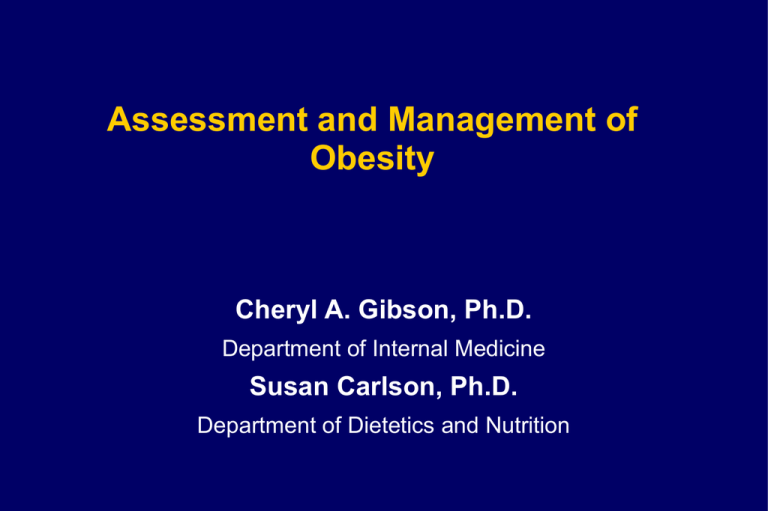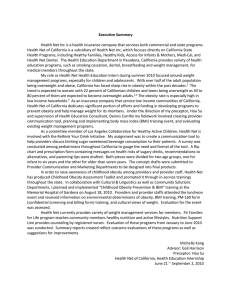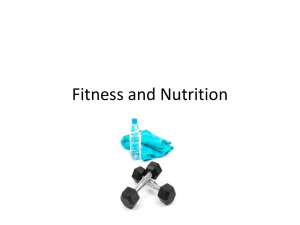ATP III: The Metabolic Syndrome Diagnosis is established when 3 of
advertisement

Assessment and Management of Obesity Cheryl A. Gibson, Ph.D. Department of Internal Medicine Susan Carlson, Ph.D. Department of Dietetics and Nutrition Objectives • Upon completion of this session, you will be able to: – Determine a patient’s level of obesity by calculating the BMI – Assess a patient’s risk status associated with obesity by analyzing the BMI, waist circumference, and co-morbidities – Assess a patient’s readiness to lose weight – Be able to work with a patient to develop a personalized strategy to address their overweight/obesity Epidemiology: Obesity/Overweight • In last 2 decades, prevalence increased by 50-100% among adults, and 3-fold among children and adolescents • 62% of US pop. are overweight, of these, 30% are obese • Higher in specific subgroups – i.e., African American women have an 80% and 50% prevalence of overweight and obesity, respectively • 29% of US adults report no regular physical activity Clinical Evaluation of Overweight and Obesity --- Assessment • Determine severity of patient’s obesity – Overweight and obesity are classified by BMI – Calculated with the formula: – Weight (kg) / height squared (m2) OR – [weight (pounds)/height squared (inches2)] * 703 Classifying Obesity by Body Mass Index • Classifying obesity by BMI units replaces previous weight-height terminology such as percent ideal or desirable body weight Desirable or healthy weight: BMI = 18.5 to 25 kg/m2 Overweight: BMI = 25 to 29.9 kg/m2 Obesity: BMI ≥ 30 kg/m2 Obesity Trends Among U.S. Adults Between 1985 and 2000 Source of the data: • The data shown in these maps were collected through CDC’s Behavioral Risk Factor Surveillance System (BRFSS). Each year, state health departments use standard procedures to collect data through a series of monthly telephone interviews with U.S. adults Clinical Evaluation of Overweight and Obesity • Assess patient’s obesity-related risk status – Waist circumference – Distribution of adipose tissue is an important consideration in addition to BMI – Measured by placing a measuring tape in a horizontal plane at the level of the iliac crest without compressing the skin Clinical Guidelines on the Identification, Evaluation, and Treatment of Overweight and Obesity in Adults: The Evidence Report. NIH Publication 98-4083. Measurement of Waist Circumference Waist Circumference • Independent risk factor for type 2 diabetes and cardiovascular disease Excess abdominal fat Men: Waist circumference > 40 inches (102 cm) Women: Waist circumference > 35 inches (88 cm) Weigh Your Patient’s Health Risks Classification of Overweight and Obesity BMI (kg/m2) Obesity Class Disease Risk (Relative to Normal Weight and Waist Circumference) M ≤ 40 in F ≤ 35 in > 40 in > 35 in < 18.5 --- --- Normal 18.5 – 24.9 --- --- Overweight 25.0 – 29.9 Increased High Obesity 30.0 – 34.9 35.0 – 39.9 I II High Very High Very High Very High Extreme Obesity ≥ 40 III Extremely High Extremely High Underweight ATP III: The Metabolic Syndrome Diagnosis is established when 3 of these risk factors are present. Risk Factor Defining Level Abdominal obesity (Waist circumference†) Men >102 cm (>40 in) Women >88 cm (>35 in) TG 150 mg/dL HDL-C Men <40 mg/dL Women <50 mg/dL Blood pressure 130/85 mm Hg Fasting glucose 110 mg/dL *Abdominal obesity is more highly correlated with metabolic risk factors than is BMI. †Some men develop metabolic risk factors when circumference is only marginally increased. Expert Panel on Detection, Evaluation, and Treatment of High Blood Cholesterol in Adults. JAMA. 2001;285:2486-2497. TM © 2002, Professional Postgraduate Services® www.lipidhealth.org NHANES III: Age-Specific Prevalence of the Metabolic Syndrome 50 45 40 Men Women 35 30 % 25 20 15 10 5 0 20-29 30-39 40-49 50-59 60-69 70 Age (y) Data are presented as percentage (SE). Ford ES et al. JAMA. 2002;287:356-359. ® © 2002 Thomson Professional Postgraduate Services® www.lipidhealth.org Metabolic syndrome: Treatment • The safest, most effective and preferred way to reduce insulin resistance in overweight and obese people is weight loss and increased physical activity (AHA, 2004) • Other steps for managing the metabolic syndrome are also important for patients and their doctors: – Routinely monitor body weight (especially the index for central obesity), blood glucose, lipoproteins and blood pressure. – Treat individual risk factors (hyperlipidemia, hypertension and high blood glucose) according to established guidelines. – Carefully choose anti-hypertensive drugs because different agents have different effects on insulin sensitivity. Other Co-morbid Conditions • Obstructive Sleep Apnea – Often overlooked in obese patients – Symptoms: • Very loud snoring • Cessation of breathing followed by a loud clearing breath • Nighttime awakening • Daytime fatigue with episodes of sleepiness at inappropriate times • Morning headaches Medical History • History is important for evaluating risk and deciding upon treatment. Questions should address: – Age of onset of obesity – Minimum weight as an adult – Events associated with weight gain – Recent weight loss attempts – Previous weight-loss modalities (successful and unsuccessful) – Complications of the above modalities Drug-induced Weight Gain • Although most common causes for overweight and obesity are excessive caloric intake and lack of physical activity, medication history should be taken also – Uncover possible drug-induced weight gain – Other medications, which might be interfering with weight loss Drug-induced Weight Gain – Drugs used to treat the following problems have been shown to cause weight gain or make weight loss more difficult Depression Schizophrenia Mood disorders Seizures Hypertension Contraindications to Treatment of Overweight and Obesity • Active cancer • Any severe illness • Pregnancy • Eating disorders • Medical or psychiatric illnesses must be stable before weight reduction begins • Patients with cholelithiasis and osteoporosis should be warned that these conditions might be aggravated by weight loss NIH Guidelines for Obesity Treatment • Aim for 5-10% sustained weight loss (>1 yr.) for best long-term effect • Weight loss maintenance difficult – Longitudinal registries illustrate 10-20% adherence (+/- 10 lbs. of total weight loss) – Tough, but important task! • 3500 calorie deficit for 1 lb. weight loss – i.e., 500 calorie deficit per day for 1 lb. weight loss per week NIH guidelines for obesity treatment, cont’d. • Creating an energy deficit – Restrict energy intake: maintain, on average, 1000-1200 kcal/day for women, 1200-1600 kcal/day for men – Increase energy expenditure: at least 150 minutes of moderate/vigorous physical activity per week, i.e., brisk walking, biking, jogging, swimming – On average, 10 minutes of vigorous activity expends about 100 calories Treatment Plan – Based on clinical evaluation of patient’s level of obesity and risk factors – Primary Targets for Treatment – Overweight patients with a BMI > 25 plus at least 2 concomitant risk factors – Obese patients with a BMI > 30, regardless of complications Treatment Modalities • Physical Activity • Behavioral Therapy • Diet • Pharmacotherapy • Surgery Goals of Non-surgical Therapies • Reduce body weight – Initial weight loss of 10% of body weight over 6 months (recommended target) – Recommended rate of weight loss is 1 – 2 pounds each week – Even modest weight may reduce visceral fat and improve co-morbid conditions • Maintain a lower body weight for the long-term • Prevention of further weight gain is the minimum goal Multifaceted Approach • Lifestyle approach (dietary therapy, PA, behavioral therapy) • Strong evidence supports multifaceted approach – far more effective for wt loss and maintenance than any single approach alone • Lifestyle interventions should be attempted for at least 6 months before considering pharmacotherapy Dietary Therapy • Goal – Reduce patients’ daily calorie intake to below maintenance level – Reduction of 500 to 1,000 kcal/day will achieve weight loss of 1 to 2 lbs/week – Women 1,000 to 1,200 calories/day – Men 1,200 to 1,600 calories/day Portion Control • Important factor in patients’ effort to lose and maintain weight – Portion sizes for many foods are much bigger now – Many people misjudge portion sizes 1 bagel = 4-6 slices of bread 1 muffin = 800 calories 16 oz steak = 1625 calories (65% of a person’s wt maintenance calories of 2500) Source: US Dept Agriculture nutrient analysis National Weight Control Registry • National database of > 3000 individuals with average wt loss of 60 lbs maintained for 5 yrs Consumed ~1400 kcal/day (24% fat calories) ~400 calories expended/day in PA (walking is the most frequent PA) 2/3 of successful weight losers were overweight as children and 60% report family history of obesity About 50% lost weight on own without formal program Successful weight losers self-monitor Popular Diets • Typically emphasize one food (and reduce another) • Successful for weight loss because they reduce TOTAL calories • Higher in protein than RDA (50 gm women, 63 gm men) • Studies have shown that 72 gm/day reduces lean tissue in most patients – No evidence that carbohydrates contribute to overweight – Insulin resistance is reduced by weight loss, no matter what diet is used to get wt loss results Formula Diets • 2 kinds of formula diets – Very low calorie diets (VLCD) – 800 calories/day – Meal replacements – Liquid or solid – Can be bought over the counter Very Low Calorie Diets • Must be physician supervised – Usually powder form (mixed with water or milk) – Required vitamins/minerals are contained in 4-5 drinks/day – Produces a rapid and consistent weight loss – Rate of weight loss should be restrained for patients with a history of arrhythmias or MI Very Low Calorie Diets (VLCDs) • VLCDs produce greater initial weight loss than LCDs, which are between 1,000 to 1,500 kcal/day • VLCDs promoted weight loss of 13 – 23 kg compared to 9 to 13 kg from LCDs • However, at 1 yr long term weight loss is not different from that of LCDs Source: Clinical guidelines on the identification, evaluation, and treatment of overweight and obesity in adults. The Evidence Report. NIH Pub #98-4083 Pharmacotherapy • Useful adjuncts to behavioral therapy • Can be considered for those with BMI of 30 – 34.9 kg/m2 regardless of co-morbid conditions • Two FDA approved drugs – Sibutramine – Orlistat Evidence Report Recommendations • Weight loss drugs may only be used as part of a comprehensive weight loss program, including dietary therapy and physical activity – With a BMI of ≥30 with no concomitant obesity-related risk factors or diseases, and – With a BMI of ≥ 27 with concomitant obesity-related risk factors or diseases • Weight loss drugs should never be used without concomitant lifestyle modifications. • Continual assessment of drug therapy for efficacy and safety is necessary – If the drug is efficacious in helping the patient lose and/or maintain weight loss and there are no serious adverse effects, it can be continued – If not, the drug should be discontinued Obesity Pharmacotherapy • Short term use is not beneficial • Without lifestyle modification drugs unlikely to be helpful • Few trials lasting 1 year or longer; attrition rates high • Net weight loss averages 2-10 kg • Most weight loss occurs within 6 months • Weight is frequently regained after therapy is stopped • Patients expectations ≠ your expectations • Evaluate risk/benefit ratio before prescribing – Initial response to therapy appears predictive • Better drugs are needed Long-term Pharmacotherapy Meta-Analysis Weight Loss Percent Weight Loss ≥ 10% weight loss Sibutramine 4.3 kg 4.6% 15% N=929 95%CI: 3.6-4.9 95%CI: 3.8-5.4% 95%CI: 4-27% Orlistat 2.7 kg 2.9% 12% N=6021 95%CI: 2.3-3.1 95%CI: 2.3-3.4% 95%CI: 8-16% Padwal et al. Int J Obesity 2003;27:1437-1446 Weight Loss Surgery • Option for patients with severe or resistant obesity • Patients with BMI at least 40 kg/m2 or less severe (BMI between 35 and 39.9 kg/ m2) if at high risk of comorbid conditions or weight-induced physical problems • Must have integrated program that provides guidance regarding diet, PA, and behavior therapy Obesity Surgical Procedures • Two operative approaches – Vertical banded gastroplasty (VBG) – Roux-en-Y gastric bypass (RYGB) • Limit storage capacity of stomach to 30 to 50 cm • Reduce pouch-emptying rate by creation of a 10mm diameter anastomotic gastrointestinal stoma Vertical banded gastroplasty (VBG) Roux-en-Y gastric bypass (RYGB) Surgical Procedures • Average wt loss of approx 50% of excess body weight • Maintained in nearly 60% of patients at 5 years • For VBG patients, no intestinal absorptive abnormalities • For RYGB patients, increased risk for micronutrient deficiencies of vit B12, folate, and calcium – Patients will need to be placed on long-term vitamin-mineral supplements Source: Am Soc Bariatric Surgery Gastric Bypass Surgery Complications: 14-Year Follow-Up Vitamin B12 239 39.9% Readmit for various reasons 229 38.2% Incisional hernia 143 23.9% Depression 142 23.7% Staple line failure 90 15.0% Gastritis 79 13.2% Cholecystitis 68 11.4% Anastomotic problems 59 9.8% Dehydration, malnutrition 35 5.8% Dilated pouch 19 3.2% Source: Pories WJ et al Ann Surg 1995;222:339-352 Summary of Recommendations Clinical Guidelines • Measurement of Degree of Overweight and Obesity to Assess Health Risks • Goals for Weight Loss • How to Achieve Weight Loss • Goals for Weight Loss Maintenance Diabetes Prevention Program (DPP) • Reduction of risk of getting type 2 diabetes – Lifestyle intervention 58% – Metformin 31% • Subgroup analyses: – Lifestyle intervention worked in all groups, but particularly well in people age 60 and older (71% reduction in dev of diabetes) – Metformin worked especially well among younger (25 to 45 yrs), heavier individuals with BMI of 36 (50 to 80 lbs overweight) National Weight Control Registry • National database of > 3000 individuals who have maintained at least 30 lb weight loss for at least one year – Successful weight losers report making substantial changes in eating and exercise habits to lose weight and maintain their losses. – The average registrant has lost approximately 60 lbs and has maintained that loss for roughly 5 years. – Two-thirds of these successful weight losers were overweight as children and 60% report a family history of obesity. – Approximately 50% of participants lost weight on their own without any type of formal program or help. – Walking is the most frequently cited physical activity performed Weight Loss Counseling in Primary Care Settings • Improvement Needed – Recent BRFSS data of over 12,800 obese adults who were seen by a physician in previous 12 months – Persons who reported receiving advice to lose weight were significantly more likely to report trying to lose weight than those who did not (OR, 2.79; 95% CI, 2.53-3.08). – Less than half of obese adults report being advised to lose weight by health care professionals. Galuska et al. Are health care professionals advising obese patients to lose weight? JAMA 1999; 282(16) Readiness to Change • Initiating Weight Control Efforts – Determining readiness and motivation are essential elements of the initial assessment – Most patients know that they have a weight problem, and some will bring up the topic – The way in which the patient is approached can influence the success of efforts to deal with it Suggestions for Initiating Discussion • Determine whether the patient sees the weight status as a problem for anyone but his or her doctor – What do you think about your weight? – Asking such a question sets the stage for addressing the patient’s weight as an issue of mutual concern Suggestions for Initiating Discussion • Focus on the health implications of the patient’s weight – Narrow the discussion to the health consequences – Labels matter. “Obesity” may be a clinical label but some obese patients find it disparaging. Describe the patient’s weight and health status, not the patient – “Your weight is in a very unhealthy range” vs “You are obese” How should you refer to your patient’s weight status • Univ of Penn study 2001 • Relative desirability of different terms that physicians might use to refer to a patient’s obesity – 127 female subjects were asked to imagine that their doctor said to them: “I want to talk with you about your _____” – Had to fill in blank with 11 possible terms – Desirability of each was rated from 1 (most desirable) to 5 (least desirable) How should you refer to your patient’s weight status? Rank Term Score 1 Weight 2.00 2 Body Mass Index 2.96 3 Excess weight 3.08 4 Unhealthy body weight 3.21 5 Weight problem 3.21 6 Unhealthy BMI 3.65 7 Heaviness 4.00 8 Large size 4.27 9 Obesity 4.42 10 Excess fat 4.48 11 Fatness 4.81 •Most preferred weight (79%) •Least preferred fatness (74%) • 54% selected obesity as one of least preferred ER Didie et al Obes Res 2001 Initiate Discussion Step One – Make the most of the patient visit and set an effective tone for communication • Patients who are overweight or obese generally have a history of dealing with a frustrating and visible problem • • Often experience discrimination and hurtful comments However, many patients are comfortable discussing weight with their physician1 Wadden TA, Anderson DA, Porter GD, et al. Arch Fam Med 2000; 9(9):854-860. 3 Steps to Initiate Discussion Step Two – Assess the patient’s motivation/readiness to lose weight – Ask the patient if he/she would consider lifestyle changes to lose weight and improve health – Example: – On a scale of 1 – 10, with 10 being 100% ready to take action, how ready are you to lose weight? Assessing Readiness to Change • If the patient agrees that weight is a problem—seize the moment to assess readiness to make changes – Warning—some patients will verbalize a willingness to change that they do not truly feel – Careful phrasing of questions may help to avoid this – Will you try to lose weight?----demands an affirmative response – Is there anything you think you can do that might help your weight situation?---may open the door to more candid responses Assessing Readiness to Change • Remember – Readiness to change is not an all or nothing matter – Patient may be willing to eliminate sugared beverages but not to begin an exercise program – After establishing the patient’s general patterns of caloric intake and activity, ask which of them the patient is willing to address initially Tips • Establishing rapport with patients – Solicit permission to discuss weight issues – Ask the patient if he/she would be comfortable with discussing general health including weight – Ask about the patient’s weight history and how excess weight has affected his/her life – Express your concerns about the health risks associated with excess weight and how this is affecting the patient – Review the patient’s BMI, waist circumference, and other associated health risks Tips • Ask the patient about previous attempts to lose weight. What were the most successful and least successful? • Ask about the patient’s physical activity level and attitude toward exercise • Ask the patient about the level of support he/she can expect from family and friends • Ask about potential barriers to success 3 Steps to Initiate Discussion (continued) Step Three • Build a partnership with the patient – Set goals for behavior change together with the patient – Recent study showed that most overweight patients would like assistance with weight management (e.g., dietary and physical activity advice) and setting realistic goals* *Potter WB, Vu JD, Croughan-Minihane M. J Fam Pract 2001; 50(6): 513-8. Tips • Ask what the patient’s weight goals are • Explain that even a small weight loss of 5 – 10 % of initial weight can lower health risks • Select 2 or 3 measurable, achievable goals and discuss steps needed to achieve them • Provide and discuss patient handouts and/or refer patient to dietitian or exercise specialist Summary • Step One – Make the most of the patient visit and set an effective tone for communication • Step Two – Assess the patient’s motivation/readiness to lose weight • Step Three – Build a partnership with the patient by setting goals for behavior change together Review Case Studies Do You Know How Food Portions Have Changed in 20 Years? National Heart, Lung, and Blood Institute Obesity Education Initiative BAGEL 20 Years Ago 140 calories 3-inch diameter Today How many calories are in this bagel? BAGEL 20 Years Ago 140 calories 3-inch diameter Today 350 calories 6-inch diameter Calorie Difference: 210 calories Maintaining a Healthy Weight is a Balancing Act Calories In = Calories Out How long will you have to rake leaves in order to burn the extra 210 calories?* *Based on 130-pound person Calories In = Calories Out If you rake the leaves for 50 minutes you will burn the extra 210 calories.* *Based on 130-pound person CHEESEBURGER 20 Years Ago 333 calories Today How many calories are in today’s cheeseburger? CHEESEBURGER 20 Years Ago Today 333 calories 590 calories Calorie Difference: 257 calories Maintaining a Healthy Weight is a Balancing Act Calories In = Calories Out How long will you have to lift weights in order to burn the extra 257 calories?* *Based on 130-pound person Calories In = Calories Out If you lift weights for 1 hour and 30 minutes, you will burn approximately 257 calories.* *Based on 130-pound person SODA 20 Years Ago 85 Calories 6.5 ounces Today How many calories are in today’s portion? SODA 20 Years Ago 85 Calories 6.5 ounces Today 250 Calories 20 ounces Calorie Difference: 165 Calories Maintaining a Healthy Weight is a Balancing Act Calories In = Calories Out How long will you have to work in the garden to burn those extra calories?* *Based on 160-pound person Calories In = Calories Out If you work in the garden for 35 minutes, you will burn approximately 165 calories.* *Based on 160-pound person Thank you for participating in Portion Distortion! For more information about Maintaining a Healthy Weight visit www.nhlbi.nih.gov






